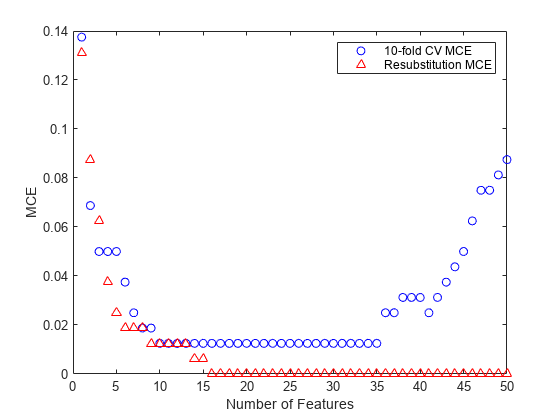降维和特征提取
PCA、因子分析、特征选择、特征提取等
特征转换方法可以通过将数据转换为新特征来减少数据的维度。当无法转换变量时(例如,当数据中存在分类变量时),最好使用特征选择方法。有关特别适用于最小二乘拟合的特征选择方法,请参阅逐步回归。
实时编辑器任务
| 降低维度 | Reduce dimensionality using Principal Component Analysis (PCA) in Live Editor (自 R2022b 起) |
函数
对象
主题
特征选择
- Introduction to Feature Selection
Learn about feature selection algorithms and explore the functions available for feature selection. - Sequential Feature Selection
This topic introduces sequential feature selection and provides an example that selects features sequentially using a custom criterion and thesequentialfsfunction. - Neighborhood Component Analysis (NCA) Feature Selection
Neighborhood component analysis (NCA) is a non-parametric method for selecting features with the goal of maximizing prediction accuracy of regression and classification algorithms.
- Regularize Discriminant Analysis Classifier
Make a more robust and simpler model by removing predictors without compromising the predictive power of the model. - Select Predictors for Random Forests
Select split-predictors for random forests using interaction test algorithm.
特征提取
- Feature Extraction
Feature extraction is a set of methods to extract high-level features from data. - Feature Extraction Workflow
This example shows a complete workflow for feature extraction from image data. - Extract Mixed Signals
This example shows how to usericato disentangle mixed audio signals.
t-SNE 多维可视化
- t-SNE
t-SNE is a method for visualizing high-dimensional data by nonlinear reduction to two or three dimensions, while preserving some features of the original data. - Visualize High-Dimensional Data Using t-SNE
This example shows how t-SNE creates a useful low-dimensional embedding of high-dimensional data. - tsne Settings
This example shows the effects of varioustsnesettings. - t-SNE Output Function
Output function description and example for t-SNE.
PCA 和典型相关
- 主成分分析 (PCA)
主成分分析通过用一组新变量替换几个相关变量来降低数据的维数,这些新变量是原始变量的线性组合。 - Analyze and Model Data on GPU
Accelerate your code by using GPU array input arguments. - Analyze Quality of Life in US Cities Using PCA
Perform a weighted principal components analysis and interpret the results.
因子分析
- Factor Analysis
Factor analysis is a way to fit a model to multivariate data to estimate interdependence of measured variables on a smaller number of unobserved (latent) factors. - Analyze Stock Prices Using Factor Analysis
Use factor analysis to investigate whether companies within the same sector experience similar week-to-week changes in stock prices. - Perform Factor Analysis on Exam Grades
This example shows how to perform factor analysis using Statistics and Machine Learning Toolbox™.
非负矩阵分解
- Nonnegative Matrix Factorization
Nonnegative matrix factorization (NMF) is a dimension-reduction technique based on a low-rank approximation of the feature space. - Perform Nonnegative Matrix Factorization
Perform nonnegative matrix factorization using the multiplicative and alternating least-squares algorithms.
多维尺度分析
- Multidimensional Scaling
Multidimensional scaling allows you to visualize how near points are to each other for many kinds of distance or dissimilarity metrics and can produce a representation of data in a small number of dimensions. - Classical Multidimensional Scaling
Usecmdscaleto perform classical (metric) multidimensional scaling, also known as principal coordinates analysis. - Classical Multidimensional Scaling Applied to Nonspatial Distances
This example shows how to perform classical multidimensional scaling using thecmdscalefunction in Statistics and Machine Learning Toolbox™. - Nonclassical Multidimensional Scaling
This example shows how to visualize dissimilarity data using nonclassical forms of multidimensional scaling (MDS). - Nonclassical and Nonmetric Multidimensional Scaling
Perform nonclassical multidimensional scaling usingmdscale.
普氏分析
- Compare Handwritten Shapes Using Procrustes Analysis
Use Procrustes analysis to compare two handwritten numerals.


